Deformation and Energy Absorption Performance of Functionally Graded TPMS Structures Fabricated by Selective Laser Melting
Abstract
:1. Introduction
2. Design of TPMS Structures
2.1. Design of Uniform TPMS Structures
2.2. Design of Functionally Graded TPMS Structures
3. Materials and Methods
3.1. Materials
3.2. Sample Processing
3.3. Microstructure Characterization
3.4. Quasi-Static Compressing Test
3.5. Numerical Modeling
3.6. Determination of Energy Absorbing Characteristics
4. Results and Discussion
4.1. Manufacturability
4.2. Experimental Validation
4.3. Energy Absorption Capability of Uniform TPMS Structures
4.4. Energy Absorption Capability of Functionally Graded TPMS Structures
5. Conclusions
- (1)
- For the same type of TPMS-based cellular structure at the same volume fraction, the sheet structures exhibited more stable deformation patterns and stress plateaus than the skeletal structures during compression, which improved the energy absorption capacity of the structures. In addition, the sheet TPMS cellular structure improved the mechanical properties in terms of compressive strength, yield strength, and plateau stress.
- (2)
- A variable functionally graded TPMS-based cellular structure design methodology was proposed to design a transverse gradient sheet TPMS structure, and the results show that the transverse gradient transformation can change the deformation pattern and cannot improve the load-bearing and energy-absorbing capacity compared with the uniform sheet TPMS structure.
- (3)
- For the degraded TPMS cellular structure, which varied the same as the compression direction, the structure was able to guide a stable deformation pattern during compression, which reduced the initial peak force and improved the crushing force efficiency. In addition, the structure exhibited a trapezoidal shape during compression, which increased the contact area and improved the compression distance. The degraded TPMS structure helps delay densification, which in turn enhances the energy absorption performance.
Author Contributions
Funding
Institutional Review Board Statement
Informed Consent Statement
Data Availability Statement
Conflicts of Interest
References
- Wang, C.; Zhu, J.H.; Wu, M.Q.; Hou, J.; Zhou, H.; Meng, L.; Li, C.Y.; Zhang, W.H. Multi-scale design and optimization for solid-lattice hybrid structures and their application to aerospace vehicle components. Chin. J. Aeronaut. 2021, 34, 386–398. [Google Scholar] [CrossRef]
- Zhu, L.; Liu, W.Q.; Fang, H.; Chen, J.Y.; Zhuang, Y.; Han, J. Design and simulation of innovative foam-filled Lattice Composite Bumper System for bridge protection in ship collisions. Compos. Part B Eng. 2019, 157, 24–35. [Google Scholar] [CrossRef]
- Aslan, B.; Yildiz, A.R. Optimum design of automobile components using lattice structures for additive manufacturing. Mater. Test. 2020, 62, 633–639. [Google Scholar] [CrossRef]
- Fina, F.; Goyanes, A.; Madla, C.M.; Awad, A.; Trenfield, S.J.; Kuek, J.M.; Patel, P.; Gaisford, S.; Basit, A.W. 3D printing of drug-loaded gyroid lattices using selective laser sintering. Int. J. Pharm. 2018, 547, 44–52. [Google Scholar] [CrossRef]
- Yin, H.F.; Zhang, W.Z.; Zhu, L.C.; Meng, F.B.; Liu, J.E.; Wen, G.L. Review on lattice structures for energy absorption properties. Compos. Struct. 2023, 304, 40. [Google Scholar] [CrossRef]
- Rahmani, R.; Antonov, M.; Brojan, M. Lightweight 3D printed Ti6Al4V-AlSi10Mg hybrid composite for impact resistance and armor piercing shielding. J. Mater. Res. Technol. 2020, 9, 13842–13854. [Google Scholar] [CrossRef]
- Dumas, M.; Terriault, P.; Brailovski, V. Modelling and characterization of a porosity graded lattice structure for additively manufactured biomaterials. Mater. Des. 2017, 121, 383–392. [Google Scholar] [CrossRef]
- Li, D.M.; Qin, R.X.; Chen, B.Z.; Zhou, J.X. Analysis of mechanical properties of lattice structures with stochastic geometric defects in additive manufacturing. Mater. Sci. Eng. A—Struct. Mater. Prop. Microstruct. Process. 2021, 822, 11. [Google Scholar] [CrossRef]
- Qiu, N.; Zhang, J.Z.; Yuan, F.Q.; Jin, Z.Y.; Zhang, Y.M.; Fang, J.G. Mechanical performance of triply periodic minimal surface structures with a novel hybrid gradient fabricated by selective laser melting. Eng. Struct. 2022, 263, 114377. [Google Scholar] [CrossRef]
- Wang, H.; Tan, D.W.; Liu, Z.P.; Yin, H.F.; Wen, G.L. On crashworthiness of novel porous structure based on composite TPMS structures. Eng. Struct. 2022, 252, 113640. [Google Scholar] [CrossRef]
- Xi, H.F.; Zhou, Z.C.; Zhang, H.H.; Huang, S.Q.; Xiao, H. Multi-morphology TPMS structures with multi-stage yield stress platform and multi-level energy absorption: Design, manufacturing, and mechanical properties. Eng. Struct. 2023, 294, 116733. [Google Scholar] [CrossRef]
- Lee, H.; Lim, C.H.J.; Low, M.J.; Tham, N.; Murukeshan, V.M.; Kim, Y.J. Lasers in Additive Manufacturing: A Review. Int. J. Precis. Eng. Manuf.-Green Technol. 2017, 4, 307–322. [Google Scholar] [CrossRef]
- Blakey-Milner, B.; Gradl, P.; Snedden, G.; Brooks, M.; Pitot, J.; Lopez, E.; Leary, M.; Berto, F.; du Plessis, A. Metal additive manufacturing in aerospace: A review. Mater. Des. 2021, 209, 33. [Google Scholar] [CrossRef]
- Tancogne-Dejean, T.; Spierings, A.B.; Mohr, D. Additively-manufactured metallic micro-lattice materials for high specific energy absorption under static and dynamic loading. Acta Mater. 2016, 116, 14–28. [Google Scholar] [CrossRef]
- Yan, C.Z.; Hao, L.; Hussein, A.; Wei, Q.S.; Shi, Y.S. Microstructural and surface modifications and hydroxyapatite coating of Ti-6Al-4V triply periodic minimal surface lattices fabricated by selective laser melting. Mater. Sci. Eng. C—Mater. Biol. Appl. 2017, 75, 1515–1524. [Google Scholar] [CrossRef] [PubMed]
- Van Bael, S.; Chai, Y.C.; Truscello, S.; Moesen, M.; Kerckhofs, G.; Van Oosterwyck, H.; Kruth, I.P.; Schrooten, J. The effect of pore geometry on the in vitro biological behavior of human periosteum-derived cells seeded on selective laser-melted Ti6Al4V bone scaffolds. Acta Biomater. 2012, 8, 2824–2834. [Google Scholar] [CrossRef] [PubMed]
- Zhang, L.; Feih, S.; Daynes, S.; Chang, S.; Wang, M.Y.; Wei, J.; Lu, W.F. Energy absorption characteristics of metallic triply periodic minimal surface sheet structures under compressive loading. Addit. Manuf. 2018, 23, 505–515. [Google Scholar] [CrossRef]
- Wang, Y.Z.; Ren, X.B.; Chen, Z.H.; Jiang, Y.B.; Cao, X.F.; Fang, S.Z.; Zhao, T.; Li, Y.; Fang, D.N. Numerical and experimental studies on compressive behavior of Gyroid lattice cylindrical shells. Mater. Des. 2020, 186, 11. [Google Scholar] [CrossRef]
- Al-Ketan, O.; Rowshan, R.; Abu Al-Rub, R.K. Topology-mechanical property relationship of 3D printed strut, skeletal, and sheet based periodic metallic cellular materials. Addit. Manuf. 2018, 19, 167–183. [Google Scholar] [CrossRef]
- Novak, N.; Al-Ketan, O.; Krstulovic-Opara, L.; Rowshan, R.; Abu Al-Rub, R.K.; Vesenjak, M.; Ren, Z. Quasi-static and dynamic compressive behaviour of sheet TPMS cellular structures. Compos. Struct. 2021, 266, 113801. [Google Scholar] [CrossRef]
- Al-Ketan, O.; Lee, D.W.; Rowshan, R.; Abu Al-Rub, R.K. Functionally graded and multi-morphology sheet TPMS lattices: Design, manufacturing, and mechanical properties. J. Mech. Behav. Biomed. Mater. 2020, 102, 17. [Google Scholar] [CrossRef]
- Yin, H.F.; Liu, Z.P.; Dai, J.L.; Wen, G.L.; Zhang, C. Crushing behavior and optimization of sheet-based 3D periodic cellular structures. Compos. Part B Eng. 2020, 182, 16. [Google Scholar] [CrossRef]
- Fan, X.J.; Tang, Q.; Feng, Q.X.; Ma, S.; Song, J.; Jin, M.X.; Guo, F.Y.; Jin, P. Design, mechanical properties and energy absorption capability of graded-thickness triply periodic minimal surface structures fabricated by selective laser melting. Int. J. Mech. Sci. 2021, 204, 12. [Google Scholar] [CrossRef]
- Feng, J.W.; Fu, J.Z.; Lin, Z.W.; Shang, C.; Niu, X.M. Layered infill area generation from triply periodic minimal surfaces for additive manufacturing. Comput.-Aided Des. 2019, 107, 50–63. [Google Scholar] [CrossRef]
- Castro, A.P.G.; Ruben, R.B.; Gonçalves, S.B.; Pinheiro, J.; Guedes, J.M.; Fernandes, P.R. Numerical and experimental evaluation of TPMS Gyroid scaffolds for bone tissue engineering. Comput. Methods Biomech. Biomed. Eng. 2019, 22, 567–573. [Google Scholar] [CrossRef] [PubMed]
- Lord, E.A.; Mackay, A.L. Periodic minimal surfaces of cubic symmetry. Curr. Sci. 2003, 85, 346–362. [Google Scholar]
- Rajagopalan, S.; Robb, R.A. Schwarz meets Schwann: Design and fabrication of biomorphic and durataxic tissue engineering scaffolds. Med. Image Anal. 2006, 10, 693–712. [Google Scholar] [CrossRef] [PubMed]
- Yuan, L.; Ding, S.L.; Wen, C.E. Additive manufacturing technology for porous metal implant applications and triple minimal surface structures: A review. Bioact. Mater. 2019, 4, 56–70. [Google Scholar] [CrossRef]
- Zhou, H.; Zhao, M.; Ma, Z.; Zhang, D.Z.; Fu, G. Sheet and network based functionally graded lattice structures manufactured by selective laser melting: Design, mechanical properties, and simulation. Int. J. Mech. Sci. 2020, 175, 105480. [Google Scholar] [CrossRef]
- Shi, J.P.; Yang, J.Q.; Li, Z.A.; Zhu, L.Y.; Li, L.; Wang, X.S. Design and fabrication of graduated porous Ti-based alloy implants for biomedical applications. J. Alloys Compd. 2017, 728, 1043–1048. [Google Scholar] [CrossRef]
- Plocher, J.; Panesar, A. Effect of density and unit cell size grading on the stiffness and energy absorption of short fibre-reinforced functionally graded lattice structures. Addit. Manuf. 2020, 33, 101171. [Google Scholar] [CrossRef]
- Limbasiya, N.; Jain, A.; Soni, H.; Wankhede, V.; Krolczyk, G.; Sahlot, P. A comprehensive review on the effect of process parameters and post-process treatments on microstructure and mechanical properties of selective laser melting of AlSi10Mg. J. Mater. Res. Technol. 2022, 21, 1141–1176. [Google Scholar] [CrossRef]
- Olakanmi, E.O.; Cochrane, R.F.; Dalgarno, K.W. A review on selective laser sintering/melting (SLS/SLM) of aluminium alloy powders: Processing, microstructure, and properties. Prog. Mater. Sci. 2015, 74, 401–477. [Google Scholar] [CrossRef]
- Wang, D.; Wu, S.B.; Fu, F.; Mai, S.Z.; Yang, Y.Q.; Liu, Y.; Song, C.H. Mechanisms and characteristics of spatter generation in SLM processing and its effect on the properties. Mater. Des. 2017, 117, 121–130. [Google Scholar] [CrossRef]
- Li, W.; Li, S.; Liu, J.; Zhang, A.; Zhou, Y.; Wei, Q.S.; Yan, C.Z.; Shi, Y.S. Effect of heat treatment on AlSi10Mg alloy fabricated by selective laser melting: Microstructure evolution, mechanical properties and fracture mechanism. Mater. Sci. Eng. A—Struct. Mater. Prop. Microstruct. Process. 2016, 663, 116–125. [Google Scholar] [CrossRef]
- Zhang, S.Y.; Yang, F.; Li, P.H.; Bian, Y.J.; Zhao, J.F.; Fan, H.L. A topologically gradient body centered lattice design with enhanced stiffness and energy absorption properties. Eng. Struct. 2022, 263, 114384. [Google Scholar] [CrossRef]
- Özen, I.; Gedikli, H.; Aslan, M. Experimental and numerical investigation on energy absorbing characteristics of empty and cellular filled composite crash boxes. Eng. Struct. 2023, 289, 116315. [Google Scholar] [CrossRef]
- Qin, R.; Wang, X.; Gao, F.; Chen, B. Energy absorption performance of hexagonal multi-cell tube with hierarchy under axial loading. Thin-Walled Struct. 2021, 169, 108392. [Google Scholar] [CrossRef]
- Yan, C.Z.; Hao, L.; Hussein, A.; Raymont, D. Evaluations of cellular lattice structures manufactured using selective laser melting. Int. J. Mach. Tools Manuf. 2012, 62, 32–38. [Google Scholar] [CrossRef]
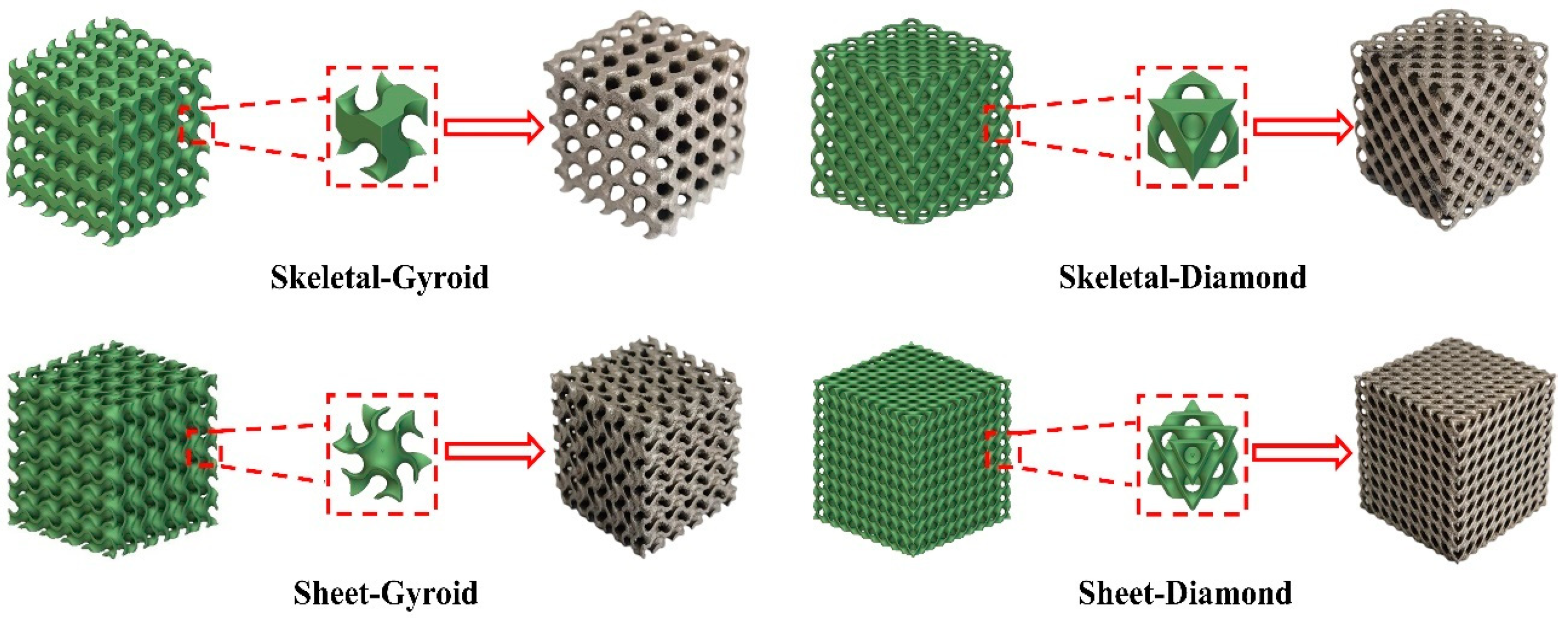

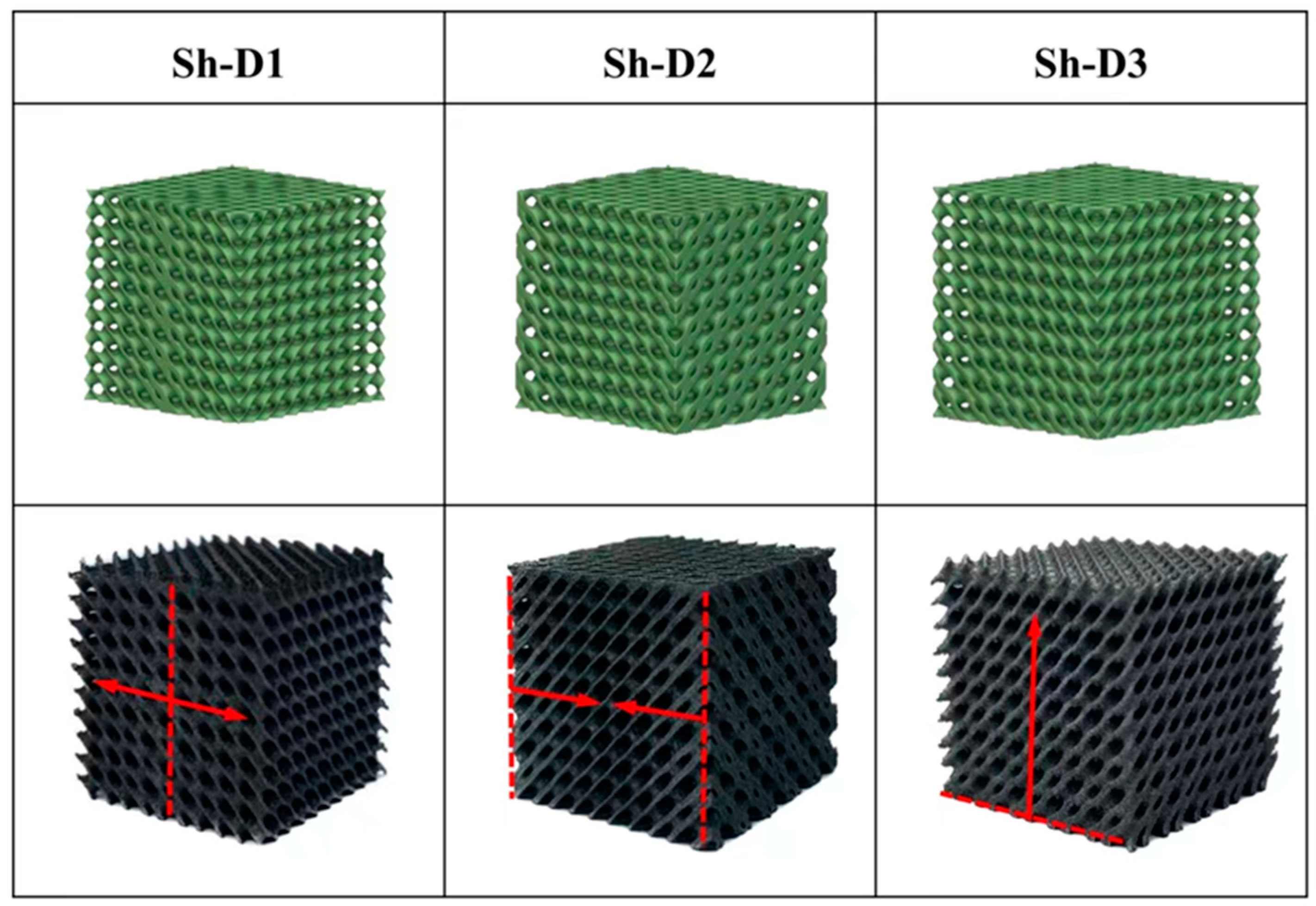
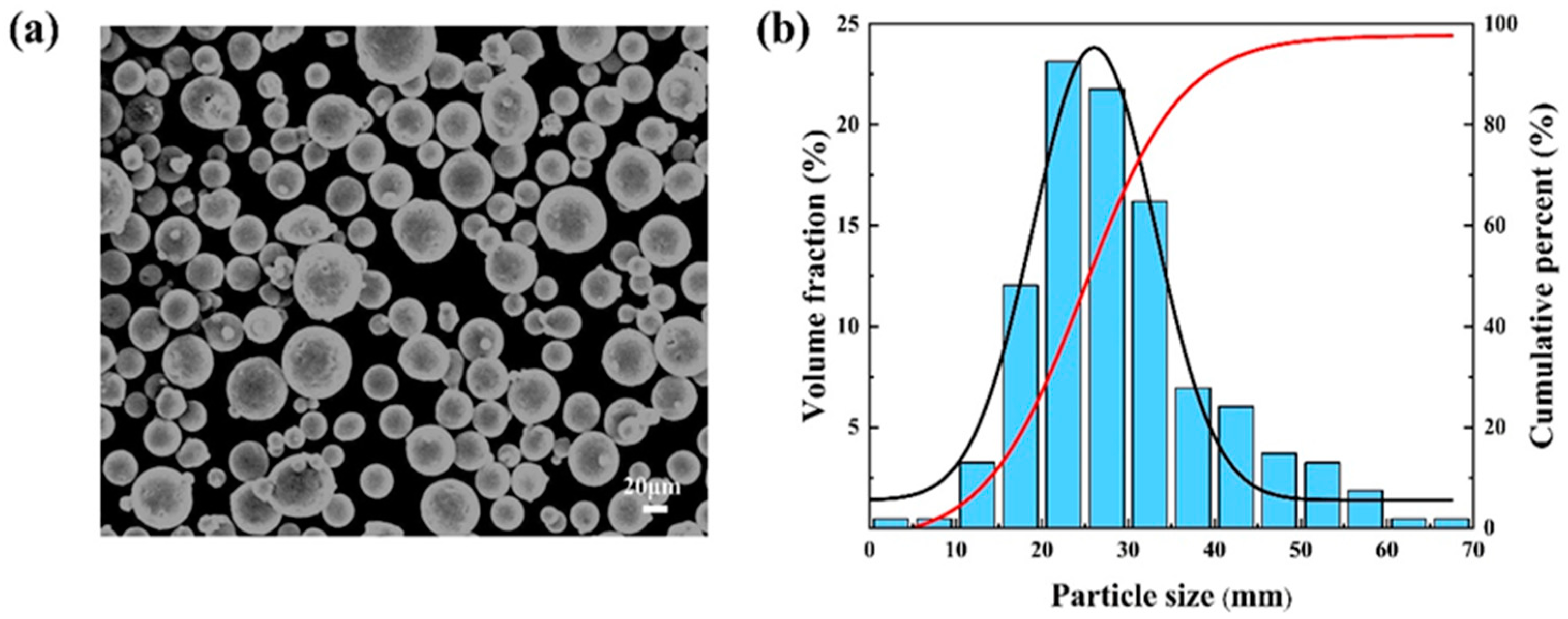
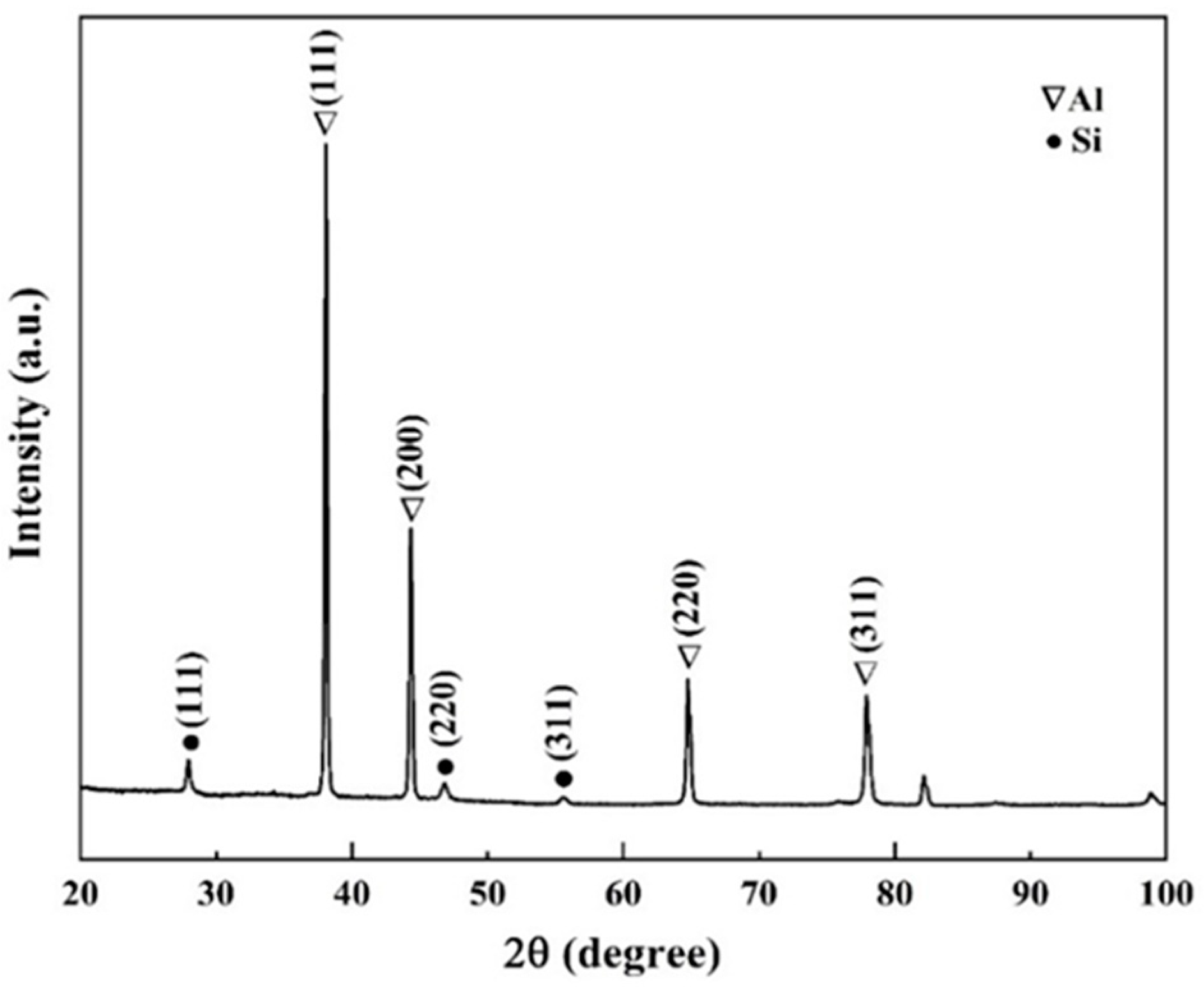

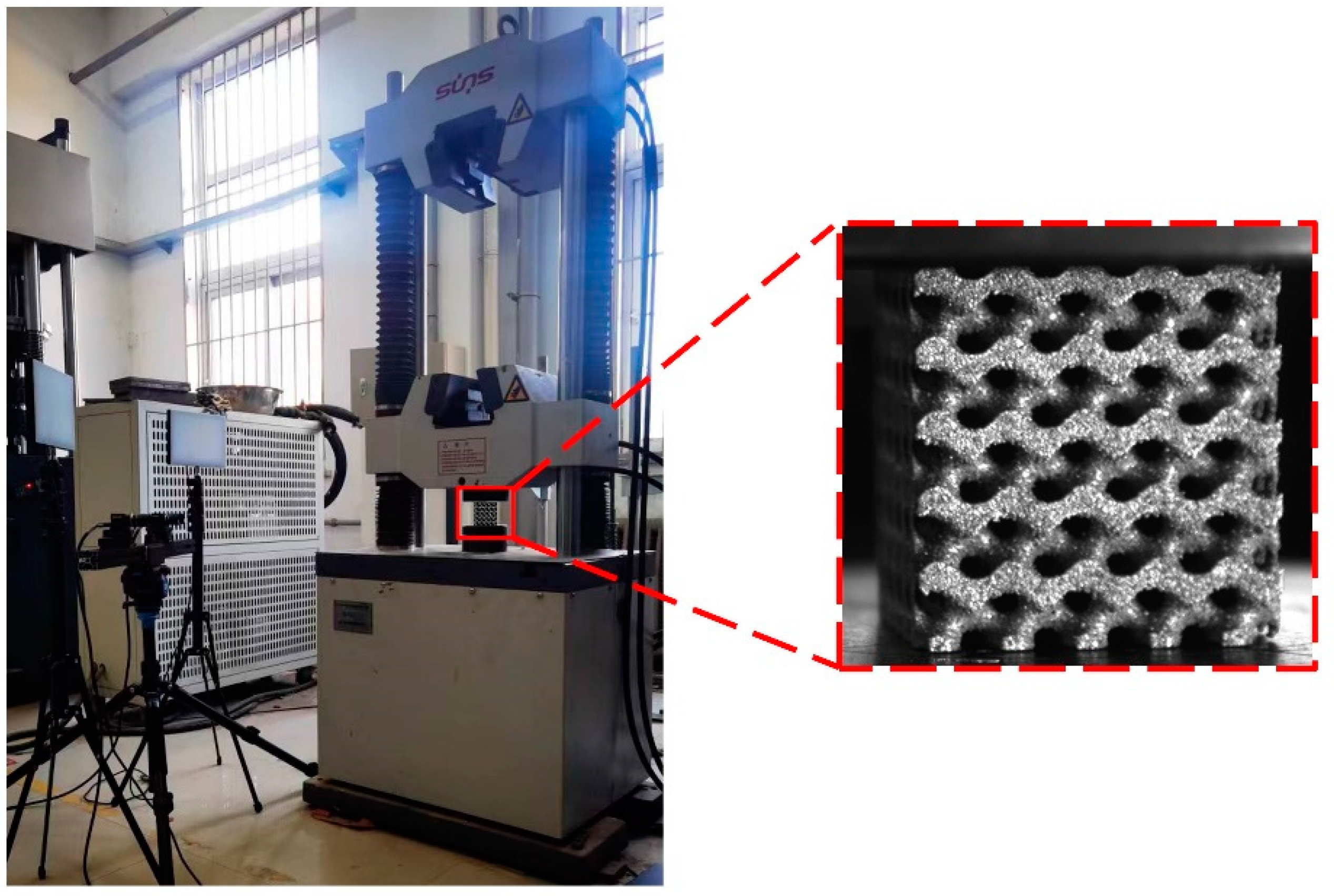
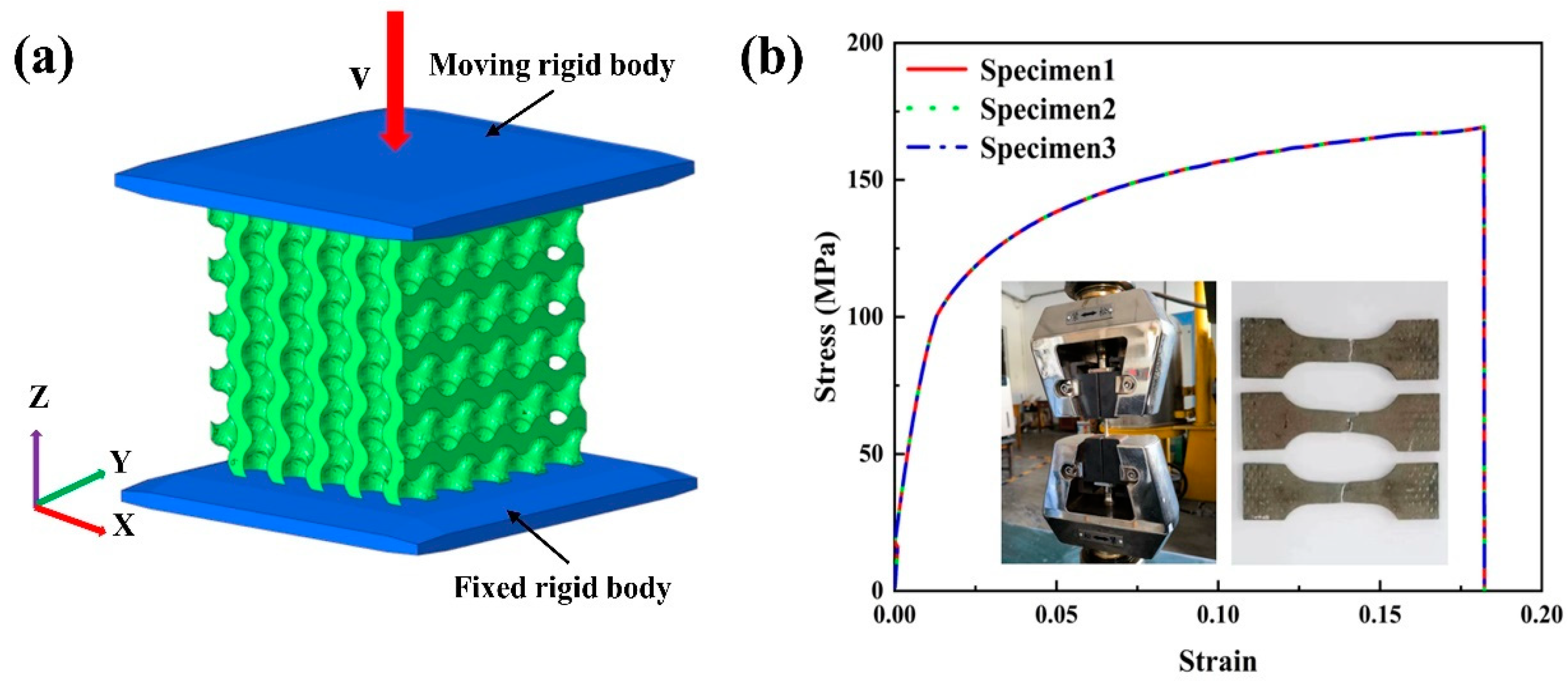
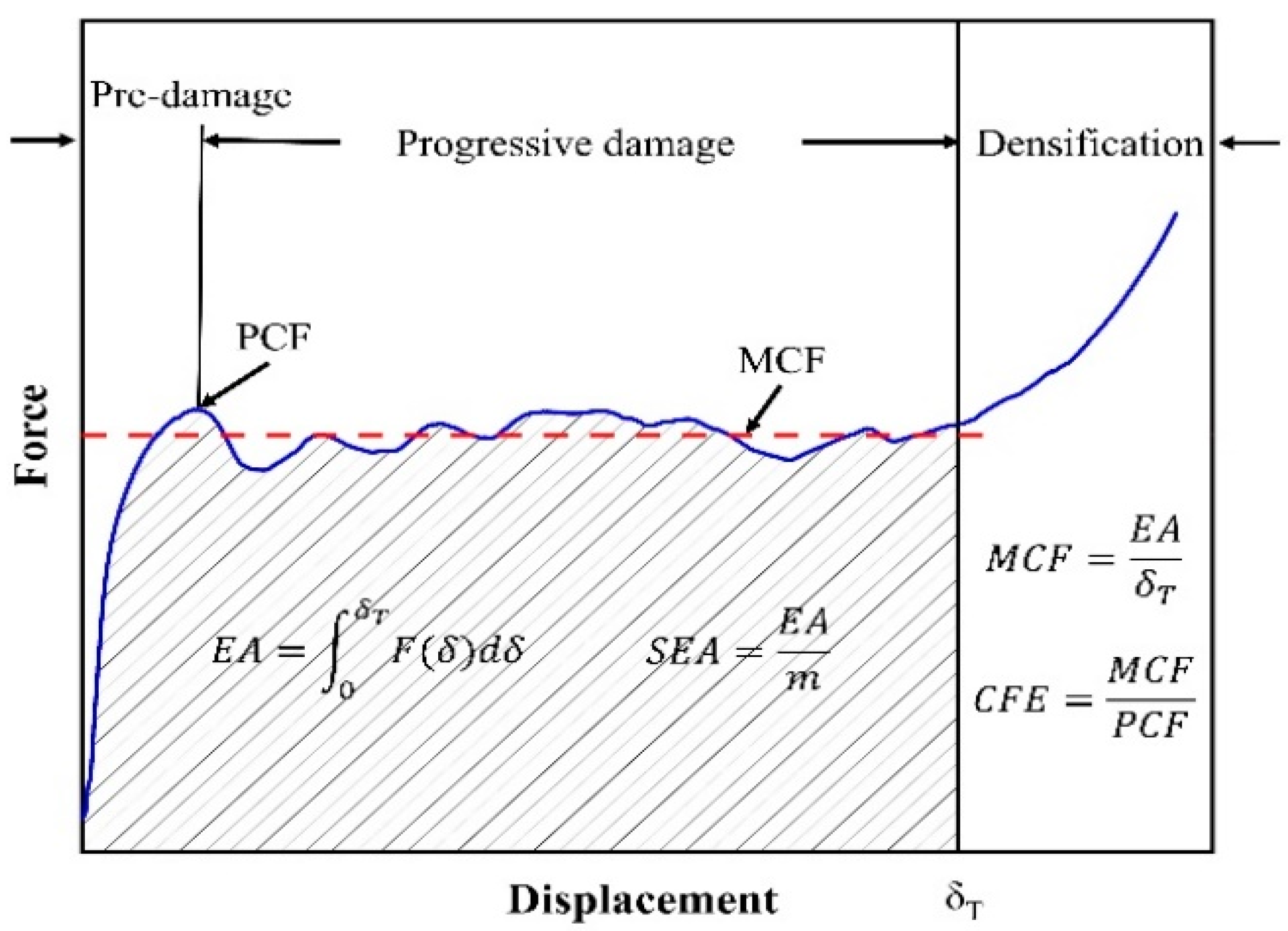
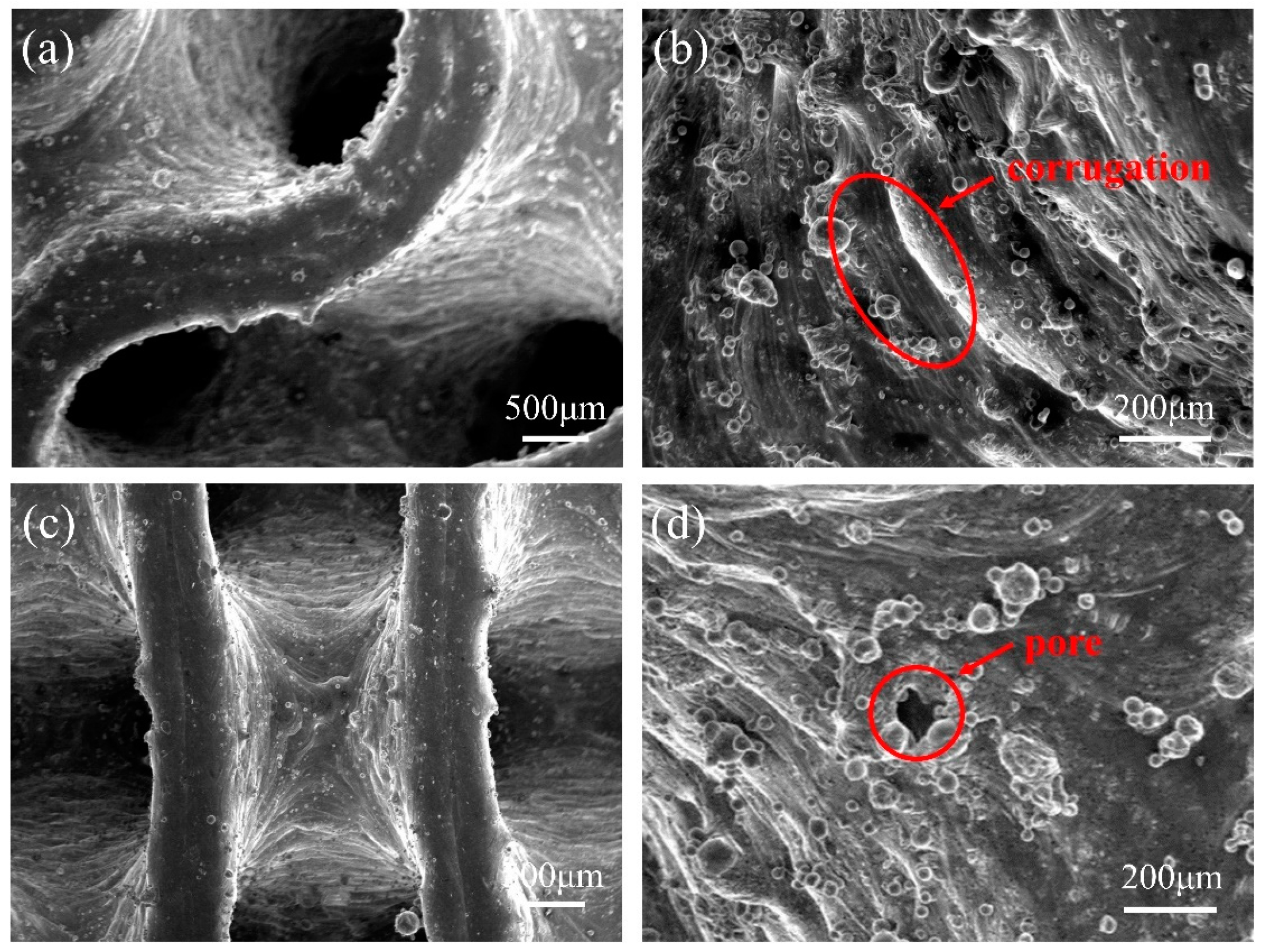

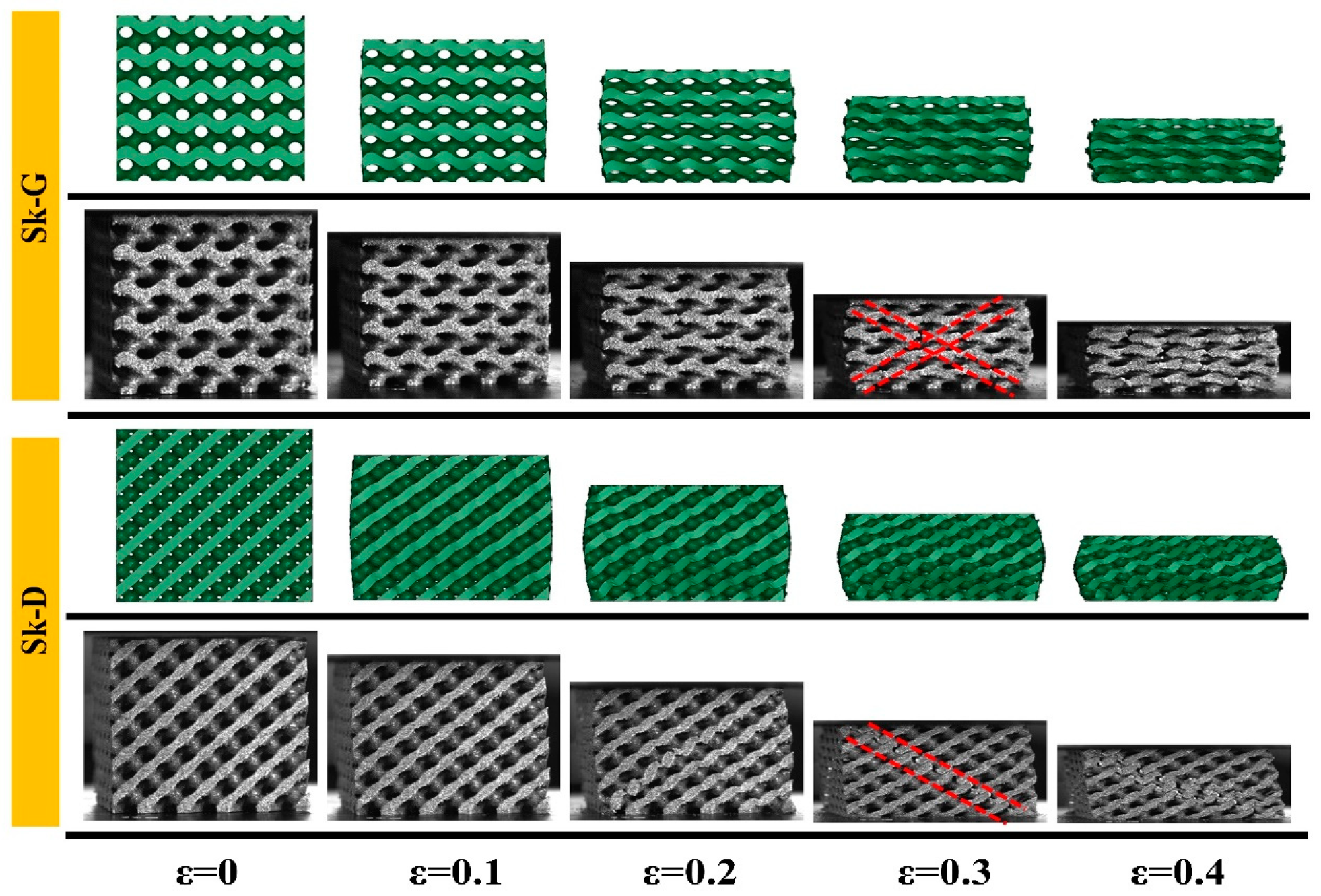
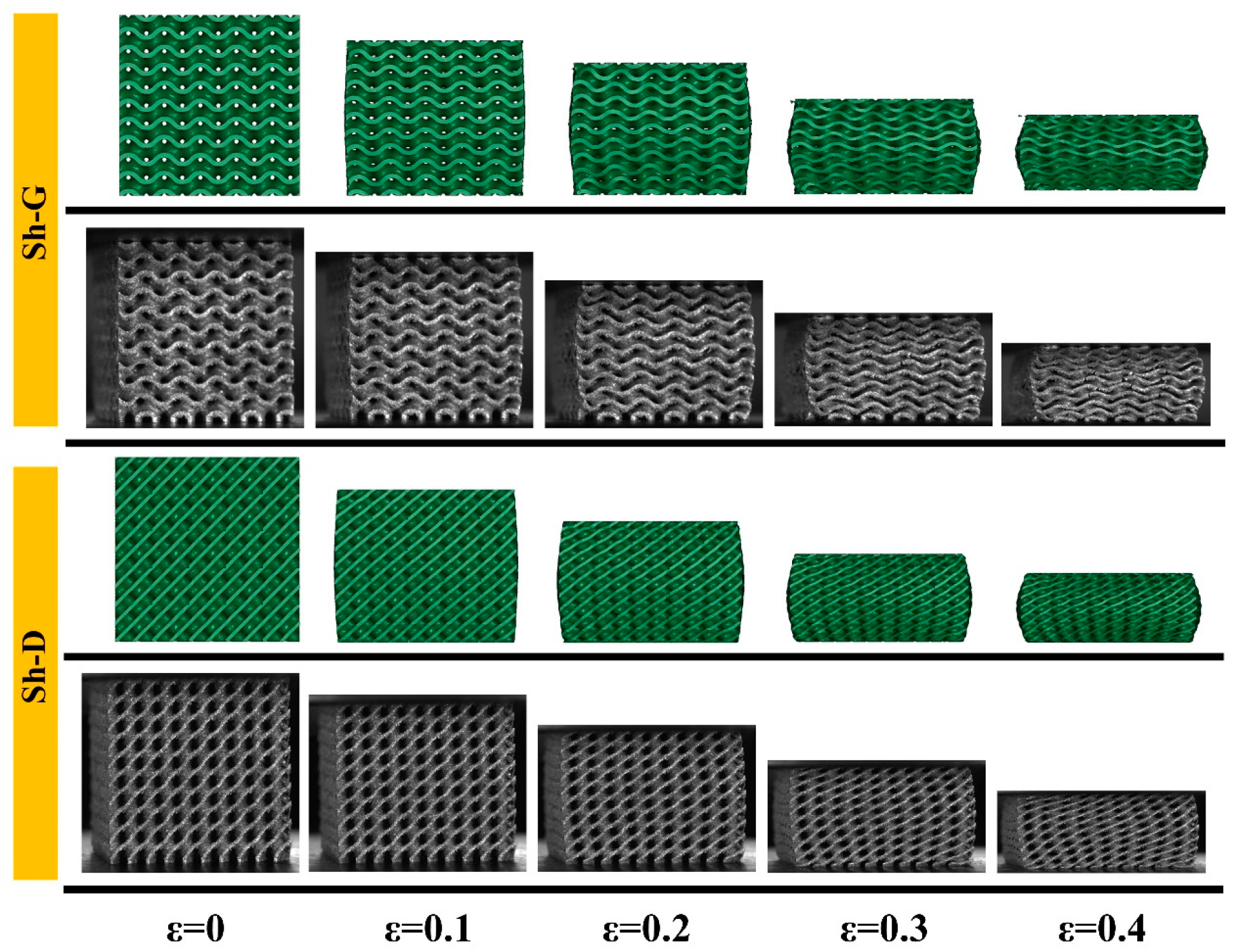

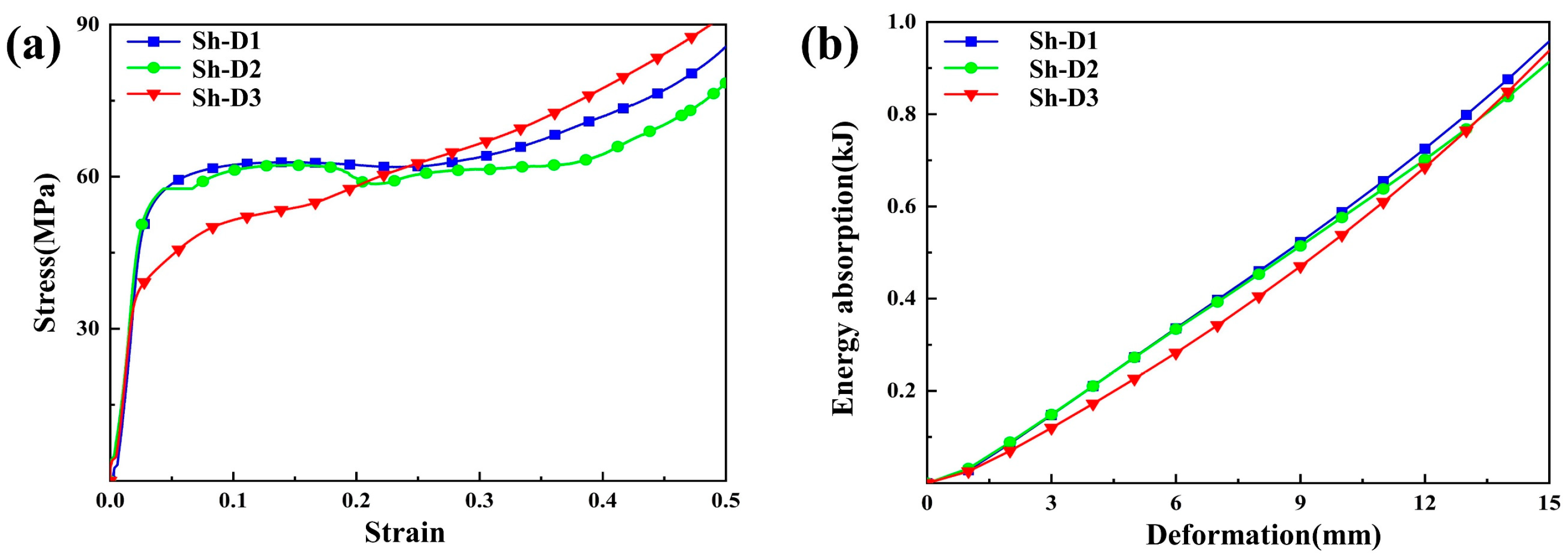


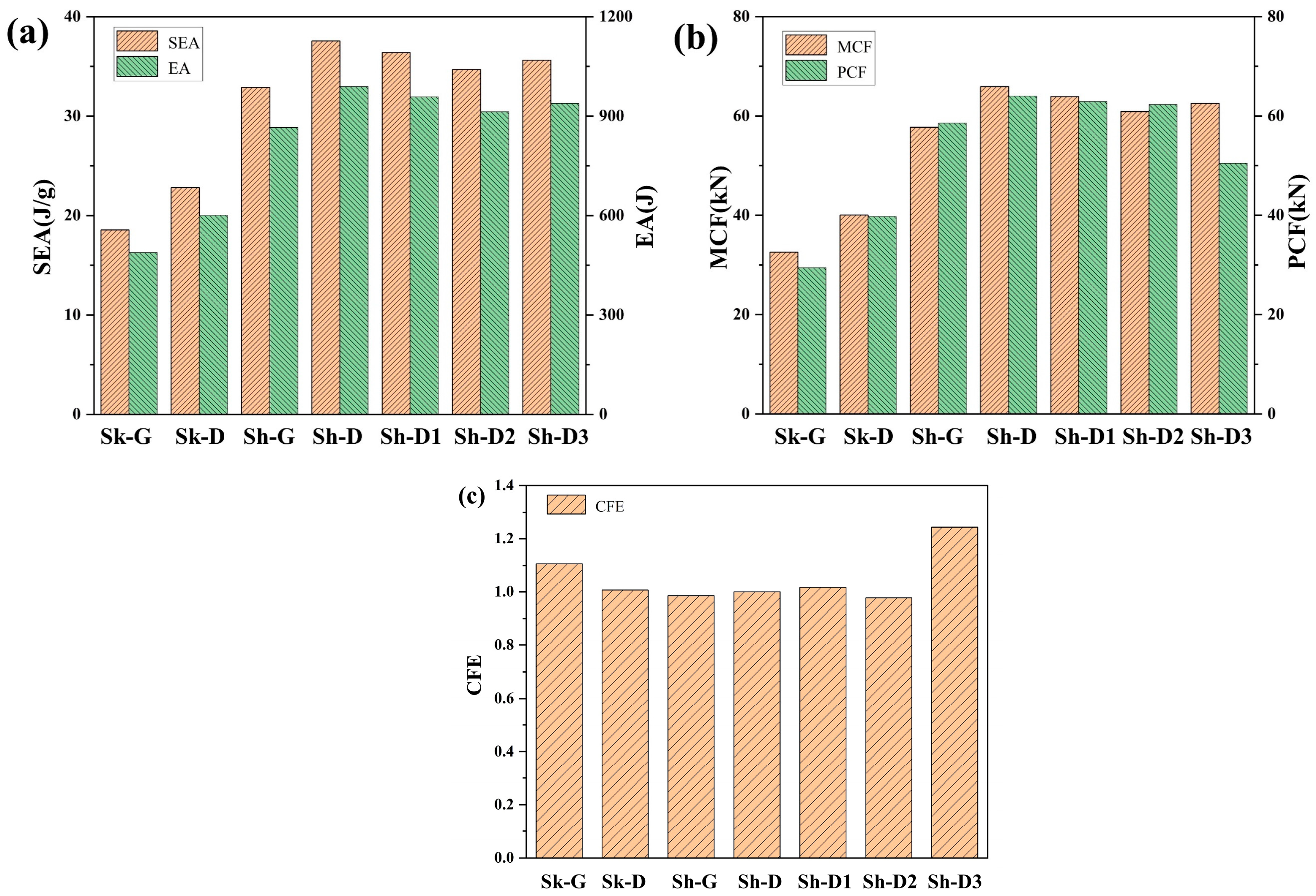
| Elements | Al | Si | Mg | Fe | Zn | Mn | Ni |
|---|---|---|---|---|---|---|---|
| Wt.% | Rest | 9.2 | 0.48 | ≤0.84 | ≤0.25 | ≤0.21 | ≤0.17 |
| Parameters | Laser Power (w) | Scanning Speed (mm/s) | Hatch Spacing (µm) | Layer Thickness (µm) |
|---|---|---|---|---|
| Values | 300 | 1100 | 140 | 30 |
| Type | Actual Mass (g) | Error | ||
|---|---|---|---|---|
| Sk-G | 0.35 | 26.572 | 0.3538 | 1.08% |
| Sk-D | 0.35 | 26.408 | 0.3521 | 0.6% |
| Sh-G | 0.35 | 26.332 | 0.3519 | 0.54% |
| Sh-D | 0.35 | 26.432 | 0.3524 | 0.69% |
| Sh-D1 | 0.35 | 26.496 | 0.3528 | 0.8% |
| Sh-D2 | 0.35 | 26.561 | 0.3536 | 1.03% |
| Sh-D3 | 0.35 | 26.665 | 0.3541 | 1.17% |
| Material | Elastic Modulus | Yield Strength | Ultimate Strength | Ultimate Strain |
|---|---|---|---|---|
| AlSi10Mg | 25.4 GPa | 116 MPa | 180 MPa | 0.17 |
Disclaimer/Publisher’s Note: The statements, opinions and data contained in all publications are solely those of the individual author(s) and contributor(s) and not of MDPI and/or the editor(s). MDPI and/or the editor(s) disclaim responsibility for any injury to people or property resulting from any ideas, methods, instructions or products referred to in the content. |
© 2024 by the authors. Licensee MDPI, Basel, Switzerland. This article is an open access article distributed under the terms and conditions of the Creative Commons Attribution (CC BY) license (https://creativecommons.org/licenses/by/4.0/).
Share and Cite
Song, J.; Wang, M.; Li, D.; Zhang, J. Deformation and Energy Absorption Performance of Functionally Graded TPMS Structures Fabricated by Selective Laser Melting. Appl. Sci. 2024, 14, 2064. https://doi.org/10.3390/app14052064
Song J, Wang M, Li D, Zhang J. Deformation and Energy Absorption Performance of Functionally Graded TPMS Structures Fabricated by Selective Laser Melting. Applied Sciences. 2024; 14(5):2064. https://doi.org/10.3390/app14052064
Chicago/Turabian StyleSong, Jian, Mengkang Wang, Dongming Li, and Jun Zhang. 2024. "Deformation and Energy Absorption Performance of Functionally Graded TPMS Structures Fabricated by Selective Laser Melting" Applied Sciences 14, no. 5: 2064. https://doi.org/10.3390/app14052064





